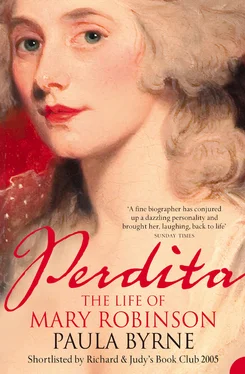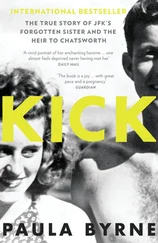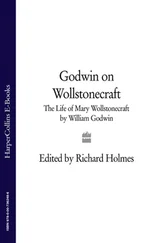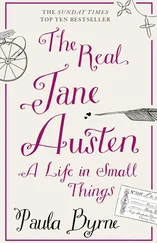At this time, Mary was increasingly subjected to the ‘alluring temptations’ of noblemen who wished to take her under their protection. Charles Manners, the fourth Duke of Rutland, offered her £600 a year for the privilege. She turned him down. She wanted the patronage of the theatregoing and poetry-reading public, not that of an aristocrat seeking a courtesan. In her Memoirs , Mary refused to name all the men who propositioned her, so as not to ‘create some reproaches in many families of the fashionable world’. 8 But she let it be known that advances were made by a royal Duke, a lofty Marquis, and a city merchant of ‘considerable fortune’. Many of these men conveyed their proposals via Mary’s milliners and dressmakers. The scurrilous Memoirs of Perdita , published in 1784 for the purpose of discrediting her, gives graphic details of her purported sexual adventures with both the conceited dandy Lord Cholmondeley and an unnamed heavy-drinking importer of vintage wines. Though not to be trusted, this source provides incidental confirmation of the impression that men from both the established aristocracy and the world of new city money had designs on her.
One of the men who paid her most attention was Sir John Lade, the wealthy heir to a brewery fortune and former ward of Henry Thrale, friend of Dr Johnson. Soon after coming of age, Lade concentrated all his energies on the Robinson household in the Great Piazza. He gambled with Tom and paid court to Mary. Gossip columnists were soon sniffing round the ménage:
A certain young Baronet, well known on the Turf, and famous for his high phaeton, had long laid siege to a pretty actress (a married woman) at one of our theatres; he sent her a number of letters, which after she had read (and perhaps did not like, as they might not speak to the purpose) she sent him back again; a kind of Bo-peep Play was kept up between them in the theatres, and from the Bedford Arms Tavern and her window. The Baronet is shame-faced, and could not address her in person, but by means of some good friend they were brought together, and on Sunday se’en-night set out in grand cavalcade for Epsom, to celebrate the very joyful occasion of their being acquainted. The Baronet went first, attended by a male friend, in his phaeton, and the lady with her husband in a post coach and four, with a footman behind it; the day was spent with the greatest jollity, and the night also, if we may believe report. Since that time they are seen together in public at the theatres and elsewhere, the husband always making one of the party, between whom and the Baronet there is always the greatest friendship. 9
Lade, who later managed the Prince’s racing stables, affected to dress and speak like a groom. He eventually married a girl called Letty, who had been a servant in a brothel. Lady Letty Lade went on to have affairs with both the Duke of York and a highwayman known as ‘Sixteen-string Jack’.
As rumour spread that Lade had won the affections of the actress, every rake in London began seeking the acquaintance of the beautiful Mrs Robinson. Sheridan was worried that his star would be tempted away by one of the men who were paying court to her. He warned Mary about her expensive lifestyle and the company she kept. The image of her younger self that she presents in the Memoirs is, to say the least, wide-eyed: ‘I had been then seen and known at all public places from the age of fifteen; yet I knew as little of the world’s deceptions as though I had been educated in the deserts of Siberia. I believed every woman friendly, every man sincere, till I discovered proofs that their characters were deceptive.’ 10 Given all that she had seen in both high society and low, she could not really have been that naive.
Despite the fact that she was treated as public property by the men who pursued her, Mary evoked this time as a golden age of theatre. Sheridan was at the peak of his reputation as a playwright and manager, following the success of his School for Scandal . He was beginning to turn his mind towards a political career and had recently met the young radical politician Charles James Fox. The green room was frequented by the nobility and ‘men of genius’ such as Fox and Lord Derby, who was to marry Elizabeth Farren: ‘the stage was now enlightened by the very best critics, and embellished by the very highest talents’. Mary also remarked that one of the reasons for Drury Lane’s popularity during this season of 1779–80 was that nearly all the principal women were under the age of twenty (a slight exaggeration). As well as herself and Farren, the lovely Charlotte Walpole and Priscilla Hopkins were on the payroll.
The public’s appetite for news, gossip, and scandal about the stage was insatiable. One of the consequences of the system of stock companies was that the audience became familiar with a small group of actors, seeing them in a variety of different roles and plays of all types, coming to know not only their styles of acting, but the details of their private lives. The proliferation of stage-related literature meant that readers were able to discover the intimate details of actors’ lives. A successful player could only have a public private life. Actors’ journals and memoirs, biographies of playwrights and managers, histories and annals of the theatre, periodicals and magazines rolled off the press. Prints and caricatures of actresses could be bought cheaply. Theatre gossip could be picked up from the newspapers, together with instant accounts of the latest performances – this was the age when professional theatre reviewing grew to maturity.
Sheridan launched his new season on 18 September 1779 with Mary as Ophelia. ‘Natural and affecting,’ said the Morning Chronicle . ‘Ophelia found a more than decent representative in Mrs Robinson,’ judged the Morning Post , ‘except in her singing, which was rather too discordant even for madness itself!’ It also noted that ‘the house, though not a very brilliant [i.e. aristocratic], was a crowded one, and both play and entertainment [the musical Comus ] went off with considerable éclat’. 11 Mary was Lady Anne in Richard III a week later.
Next, she reprised her Fidelia in The Plain Dealer . Her costume drew attention, though the critic in the Morning Post tried to give the impression that he was only looking at it from the point of view of dramatic verisimilitude, not that of the shapely leg to which it clung:
Fidelia was performed with great ease and feeling by Mrs Robinson, and is by far the best character she has hitherto attempted; but as propriety of stage dress should always be strictly attended to, particularly in the professional characters, it may not be improper to inform Mrs Robinson, that Fidelia as a Volunteer cannot wear a Lieutenant’s uniform, without a violation of all dramatic consistency. 12
She played fifty-five nights that season, adding to her repertoire Viola in Twelfth Night , Nancy in The Camp , Rosalind in As You Like It , Oriana in George Farquhar’s The Inconstant , Widow Brady (‘with an Epilogue Song’) in Garrick’s The Irish Widow , and Eliza Camply in The Miniature Picture by Lady Elizabeth Craven. As Oriana, she had to win over a reluctant lover by engaging in various schemes including dressing as a nun, feigning madness, and disguising herself as a page-boy. As the Irish Widow, she had to mimic a strong brogue, put down an assortment of men, talk about her clothes, claim that she despised money, and cross-dress as a sword-bearing officer called Lieutenant O’Neale. But it was the Shakespearean breeches roles of Viola and Rosalind that were her greatest triumph. She revealed a gift for both the expression of Shakespeare’s language and the characters’ emotional range – from pathos through wit to fortitude and command.
Читать дальше












